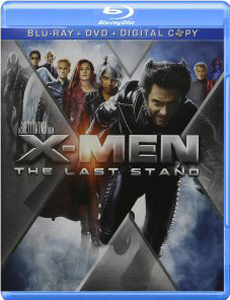We now arrive at the capper of the original “X-Men” trilogy, “X-Men: The Last Stand” (2006). It’s a widely maligned film, partly because it’s the first to introduce plot holes into the saga. Beast is human in “X2,” but mutant here. Xavier resurrects himself in the post-credits scene, but how did he do it?
Although I’m not enamored by the most-hyped element of “The Last Stand” – the adaptation of the famed Dark Phoenix comic-book plot – I think the film is decent, with more graspable ideas than “X2” despite peppering the screen with even more new mutants than its predecessor.
THE STORY
Mutant-human relations have progressed nicely since “X2,” with Beast being a close advisor and friend to the President of the United States. But old wounds reopen when Warren Worthington Jr. – inspired to help his wing-sprouting son (who will become Archangel) – develops a cure for mutanthood, synthesizing it from a mutant kid named Jimmy, who cancels out mutants’ powers when they’re around him.

“X-Men: The Last Stand” (2006)
Director: Brett Ratner
Writers: Simon Kinberg, Zak Penn
Stars: Patrick Stewart, Hugh Jackman, Halle Berry
Some mutants, such as Rogue (and Beast also gives voice to this point of view) are intrigued by the idea of becoming normal, while others are offended to the point of mass protests. Magneto, always wary of his potential enemies in the government, realizes that this cure can also be used as a weapon. Indeed, he sees Mystique get shot by a dart and become normal, then abandons her as she is “no longer one of us.” The stage is set for an epic final battle at Worthington Labs on Alcatraz Island, where a smorgasbord of mutants are thrown at the screen.
Arguably, that’s enough of a movie right there, but “The Last Stand” also finds Jean Grey split into two personalities. She can’t control the darker half (known as The Phoenix), which kills Cyclops and Professor Xavier and is on her way to offing Wolverine except that he kills her first, finally giving up on the notion of saving this confused and suicidal woman’s life even though he loves her.
BEST GOOD GUY MUTANT
Beast. Kelsey Grammer’s Beast feels like he jumps right off the comic pages, both in his cerebral Economist-reading scenes and action scenes. Grammer’s portrayal continues nicely from Nicholas Hoult’s in the prequels, and Beast’s old-school X-Men costume is a nice bit of continuity. Had the saga been made with a more pre-planning, we perhaps would’ve heard Beast talk more about his struggles with self-confidence and his hits and misses with finding a cure (we saw him in human form in “X2,” and his experimentation with a cure was explored in “First Class”). Still, if you read between the lines, his arc works pretty well.
BEST BAD GUY MUTANT
Juggernaut. His action scenes are awesome, with the way the camera shakes with his every step. A highlight is when he’s chasing Shadowcat through the Worthington Labs: She phases through each successive wall, and he simply smashes through them.

WORST MUTANT
Jean Grey. Her Phoenix arc reminds me of Dark Willow from Season 6 of “Buffy,” but with less substance (and I wasn’t all that fond of Dark Willow, either). I know it’s based on the beloved Dark Phoenix comic book arc, but it doesn’t translate well to the screen because Jean’s struggle between her two personalities is mostly inner turmoil. Chris Claremont’s novelization fleshes it out a little, but also affirms that there’s not much for Famke Janssen to play with on the big screen.
BEST NON-MUTANT
Warren Worthington Jr. Archangel’s dad epitomizes the struggles a parent goes through in the world of “The Last Stand,” where mutants – despite being gradually more accepted by society – are destined to have a tougher life than normal humans. He develops the cure for his son, then learns the hard way (as Magneto’s henchmen throw him off a building) that his good deed was not taken as such. After Angel saves his life, we know Worthington will rethink his stance on mutanthood.
MOST UNDERUSED MUTANT
Kitty Pryde. Up-and-coming young actress Ellen Page was cast in the role of this fan-favorite X-Man who can walk through walls, supplanting two Kitty actresses who had brief scenes in the trilogy’s previous entries. While Shadowcat gets one great action scene where she outsmarts Juggernaut, and one sweet ice-skating scene with Bobby, Page isn’t given much of a chance to show her acting chops. A potentially compelling love triangle between Kitty and Iceman and Rogue is only hinted at.
CONTINUITY NOTES AND ODDITIES
As with “X2,” Claremont’s “Last Stand” novelization finds the author digging deeper into the material and inadvertently creating continuity problems with the later-filmed prequels. The president’s military advisor is named Bolivar Trask, the same name as Peter Dinklage’s Sentinel creator in “Days of Future Past.” Claremont refers to this film’s Moira MacTaggart as Xavier’s former lover.
But that doesn’t quite jibe, as the “First Class” Moira, who was more or less Charles’ love interest, should be Xavier’s age. Instead, she’s about half his age. And Claremont briefly introduces Gambit as a young X-Man, but he is an adult mutant in “Origins: Wolverine.” Luckily, if we consider just the film itself to be canon, we can say this is a different Trask, Moira is the original Moira’s daughter, and Gambit isn’t in the movie.
In the movie, Rogue chooses to get the cure. In the novelization, she chooses not to get the cure. Interestingly, her character arc works either way, because as Logan tells her, the important thing is that she does what’s right for her. I like the film’s portrayal, because it allows both sides of the argument to be shown: The cure was not right for Angel or Beast, but it is right for Rogue. Advances in medicine allow for free-market choice, and that’s a good thing.
Interestingly, the 2023 portion of “Days of Future Past” almost caused a continuity gaffe by showing Rogue using her powers, but that was edited out for other reasons (and now Rogue is barely in the movie at all). Then again, Magneto is shown regaining his powers in the final shot of “The Last Stand,” and indeed, he has full use of his powers in the 2023 part of “Days of Future Past.” So perhaps the cure is similar to the serum that allows Xavier to walk for a bit – it’s not as permanent as Worthington thought.
Beast doesn’t react too strongly to seeing the video of Mystique in action, but he pauses just long enough that an imaginative viewer can surmise that he’s reflecting a bit on his former potential flame.
Without explanation, “X2’s” breakout star Nightcrawler isn’t in “The Last Stand.” I suspect the real-world answer is that the filmmakers wanted to focus their special-effects efforts on Beast this time.
In the Danger Room, the X-Men take on a Sentinel. We now know that “Days of Future Past” is when Xavier’s team encountered the Sentinels, which were designed by Bolivar Trask (not to be confused with “The Last Stand’s” Trask).
Professor Xavier transfers his essence (and voice) into a brain-dead man that Moira had been caring for, and who was referenced in Xavier’s lesson on ethics. Later, in the bonus scene from “The Wolverine,” we’ll see that Xavier has transferred completely into his Patrick Stewart visage. This suggests that 1) Xavier has powers beyond telepathy and brain transference, or 2) that he got help from another mutant in morphing his new body to look like his old one, or 3) the body already looks like him because it was his twin brother.
The latter possibility would explain why Moira, a friend of Charles’, was taking care of the body (which we don’t see clearly). Indeed, the idea of someone with a powerful brain having a brain-dead twin has a nice symmetry to it. Unfortunately, the details of Xavier’s resurrection will probably remain a mystery, seeing as how “Days of Future Past” didn’t address it.
WHERE IT RANKS
I rank this movie below “First Class” and “X-Men” and a slight notch above “X2” and “Origins Wolverine.” I think “The Last Stand’s” through-line works a bit better than those latter two overloaded films, although the disappointingly bland Dark Phoenix plot causes it to lose some points.
I like how the “cure” theme is brought to the fore after being teased in the previous movies. It can be viewed as a metaphor for the controversy over whether homosexualty is something to be cured, but it also calls to mind abortion clinics with the way the police guard the entrance to the lab and usher in the patients amid protesting throngs.
Archangel’s arc is the most clichéd, as he struggles to gain self-confidence and his father’s approval despite having gigantic wings. More intriguing is Rogue wrestling with her decision, but it’s a bit underplayed, and I also wish Beast would’ve had more to say on this subject, considering his past (somewhat successful, we can surmise since he’s in human form in “X2”) attempt to create a cure.
While I would’ve liked beefier character stuff in “The Last Stand,” I have to admit the action scenes, particularly the big Alcatraz battle at the end, are fun. We get Shadowcat phasing, Juggernaut smashing, Pyro and Iceman squaring off with fire and ice, and Colossus throwing Wolverine through the air (a popular tactic in the comics, I think).

